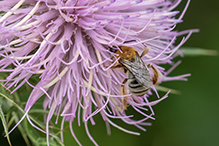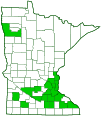Pruinose squash bee
(Peponapis pruinosa)
Conservation • Description • Habitat • Ecology • Distribution • Taxonomy
Conservation Status |
|||
| IUCN Red List | not listed |
||
| NatureServe | NNR - Unranked SNR - Unranked |
||
| Minnesota | not listed |
||
Description
Pruinose squash bee is a common, medium-sized, solitary, ground-nesting, longhorn bee. It occurs throughout most of the United States, but it is absent from the Great Basin and from Washington, northern Idaho, and Montana, and it is mostly absent from the Great Plains. It occurs in southern Canada from Nova Scotia to Ontario, and it occurs throughout Mexico.
The pruinose squash bee is a pollen specialist that collects pollen exclusively from squash plants (Family Cucurbitaceae). Its distribution is closely tied to its host plants. It is found in agricultural croplands and vegetable gardens (including suburban ones) where cultivated squash, zucchini, and pumpkins (Cucurbita spp.) are grown. It is found in natural areas only in its native range where its wild gourd hosts are present. This does not include the eastern U.S. or Minnesota.
Adults are active from June to September. The timing coincides with the flowering of their local host plants. They fly early in the day. The males sleep inside squash blossoms, which close by mid-morning. While they sleep, the females prepare their solitary nests, which require patches of bare, well-drained soil, often on the edge of or right under the plants. Though not social, they often group their nests close together (gregarious).
The female is ½″ to 9⁄16″ (12.5 to 14.0 mm) in length. The body is robust and extremely hairy.
The head is as wide as the thorax and is densely covered with long, more or less erect, light yellowish-brown hairs. The plate on the face above the upper lip (clypeus) sticks out rather strongly from the face. It is entirely black, with little to no obscure yellowish toward the tip. At its widest point, the space between it and the compound eye is very small, equal to or only slightly more than the space between the bottom of the compound eye and the mandible (malar space). Near the inner margin of each compound eye there is no row of stiff hairs that stick straight up. The top of the is head flat, causing the simple eyes (ocelli) to bulge out. There is an obscure yellowish spot at the end of the jaws (mandibles). The antennae are black and they have 12 segments, a long scape at the base, a short pedicel, and a whip-like section (flagellum) with 10 segments (flagellomeres). The first flagellomere is as long as the second and third combined.
The thorax is densely covered with long, more or less erect hairs. The hairs on the thorax are shorter, denser, and somewhat more reddish-yellow or tawny than those on the head. The small plate on each side, above the base of the wing (tegula), is translucent yellowish and perfectly oval, not tear-drop shaped. Unfortunately, it is hidden beneath long hairs and cannot be seen without scraping the hairs away.
The first segment (tergite) of the abdomen (T1) is covered with abundant, rather long, light yellowish-brown hairs at the front and sides. A narrow band along the rear margin is bare. T2 has a narrow band of pale hairs on the front margin that is narrowed in the middle and connects on the sides with a broader band on the rear margin. T3 and T4 have a broad band of pale hairs at the rear margin. T5 is densely covered with long, light yellowish-brown hairs.
The legs are hairy and mostly black. The pollen-collecting hairs (scopa) on the fourth segment (tibia) of the hind leg are pale yellowish-brown and are mostly simple, very sparsely feather-like (plumose). The last part of each leg (tarsus), corresponding to the foot, has five segments. The last segment is yellowish brown.
The wings are clear. The veins are brownish black to black.
The male is 7⁄16″ to ½″ (11 to 13 mm) in length. The clypeus sticks out strongly. It is mostly black with a yellow area near the bottom. The first flagellomere is rather short. The third flagellomere is twice as long as the first, and the second is even longer than the third. The wing veins are yellowish brown to brownish black.
Size
Female total length: ½″ to 9⁄16″ (12.5 to 14.0 mm)
Male total length: 7⁄16″ to ½″ (11 to 13 mm)
Similar Species
Habitat
Agricultural croplands and vegetable gardens
Ecology
Season
June to September
Behavior
Pruinose squash bees are fast fliers. They fly early in the morning, when squash blossoms are open.
Males sleep inside squash blossoms.
Life Cycle
The female builds a solitary nest on bare ground, often under or near a host plant.
Larva Food/Hosts
Pollen
Adult Food
Distribution |
||
|
Sources |
|
| 10/6/2025 | ||
Occurrence |
||
Common and widespread |
||
Taxonomy
Order
Hymenoptera (Ants, Bees, Wasps, and Sawflies)
Suborder
Apocrita (Narrow-waisted Wasps, Ants, and Bees)
Infraorder
Aculeata (ants, bees, and stinging wasps)
Superfamily
Apoidea (bees and apoid wasps)
Epifamily
Family
Apidae (honey bees, bumble bees, and allies)
Subfamily
Apinae (honey, bumble, longhorn, orchid, and digger bees)
Tribe
Eucerini (longhorn bees)
Genus
Peponapis (squash bees)
Genus
A recent analysis of the longhorn bee tribe Eucerini (Freitas et al., 2023) proposed among other things “taxonomic changes, including a new subtribal classification and reorganized generic and subgeneric limits.” The genus Peponapis was moved into Xenoglossa as a subgenus. The proposed move of the genus Peponapis has not been widely accepted.
Subordinate Taxa
Synonyms
Eucera pruinosa
Macrocera pruinosa
Xenoglossa angelica
Xenoglossa howardi
Xenoglossa pruinosa
Xenoglossa pruinosa ssp. lutzi
Common Names
pruinose squash bee
Glossary
Clypeus
On insects, a hardened plate on the face above the upper lip (labrum).
Flagellomere
A segment of the whip-like third section of an insect antenna (flagellum).
Ocellus
Simple eye; an eye with a single lens. Plural: ocelli.
Pedicel
On plants: the stalk of a single flower in a cluster of flowers. On insects: the second segment of the antennae. On Hymenoptera and Araneae: the narrow stalk connecting the thorax to the abdomen: the preferred term is petiole.
Plumose
Feathery; having fine, pinnately arranged, lateral bristles or hairs arranged on both sides of an axis.
Scape
In plants: An erect, leafless stalk growing from the rootstock and supporting a flower or a flower cluster. In insects: The basal segment of the antenna.
Scopa
A brush-like tuft of hairs on the legs or underside of the abdomen of a bee used to collect pollen.
Tarsus
On insects, the last two to five subdivisions of the leg, attached to the tibia; the foot. On spiders, the last segment of the leg. Plural: tarsi.
Tergite
The upper (dorsal), hardened plate on a segment of the thorax or abdomen of an arthropod or myriapod.
Tibia
The fourth segment of an insect leg, after the femur and before the tarsus (foot). The fifth segment of a spider leg or palp. Plural: tibiae.
Visitor Photos
Share your photo of this insect.
This button not working for you?
Simply email us at info@MinnesotaSeasons.com.
Attach one or more photos and, if you like, a caption.
Greg Watson |

|
MinnesotaSeasons.com Photos
|

Slideshows
Peponapis pruinosa
Sam Droege

Visitor Videos
Share your video of this insect.
This button not working for you?
Simply email us at info@MinnesotaSeasons.com.
Attach a video, a YouTube link, or a cloud storage link.
Other Videos
Busy Bee Butts (Peponapis pruinosa)
Drew Scott



